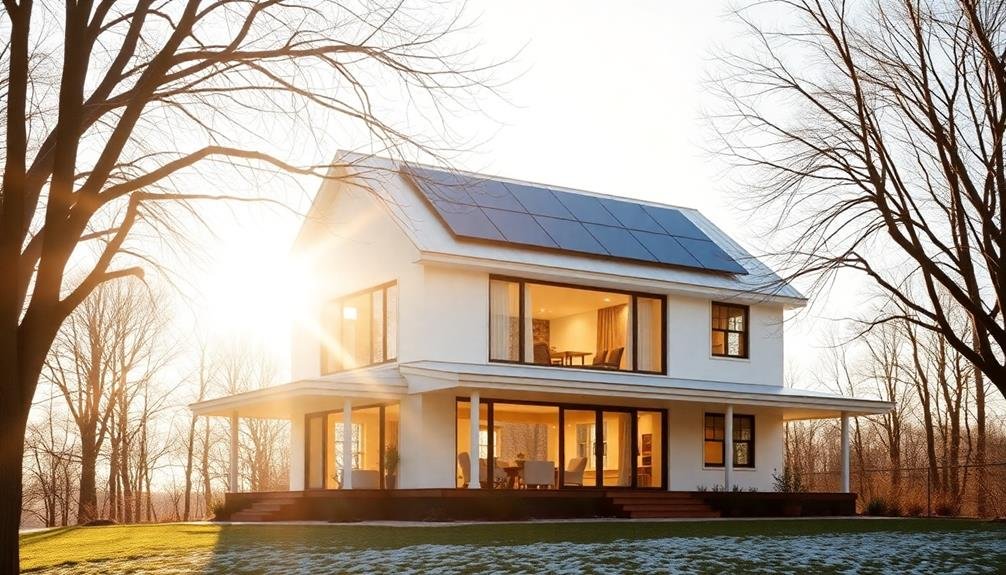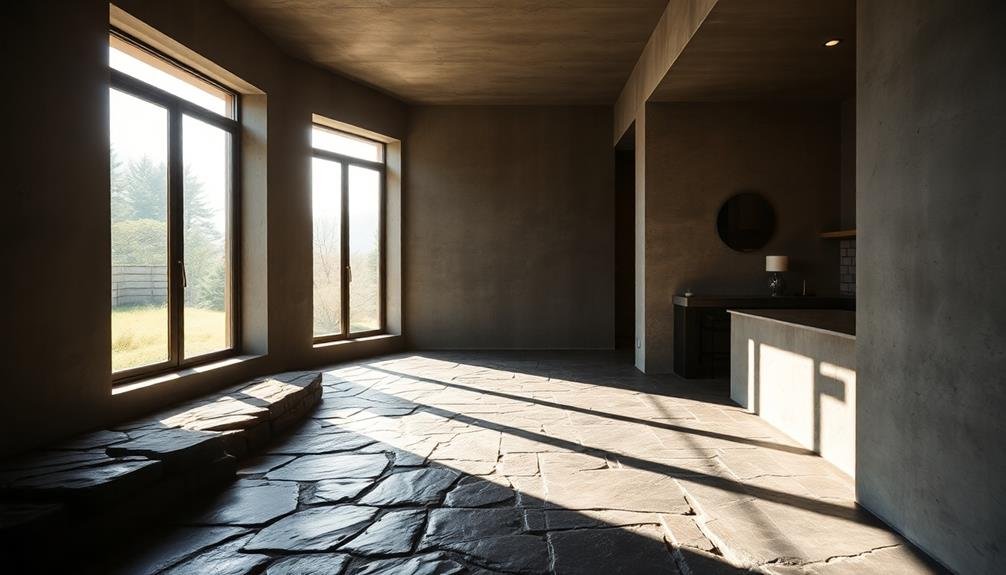To maximize energy savings through solar orientation, you'll want to focus on three key strategies. First, prioritize large, south-facing windows with energy-efficient glazing to capture ideal sunlight. Second, optimize your roof angle, typically between 30 and 45 degrees, to enhance solar panel efficiency based on your location. Third, strategically position thermal mass materials like concrete or stone near south-facing windows to absorb and release heat effectively. By implementing these techniques, you'll considerably reduce your energy consumption and create a more comfortable living space. Discover how these strategies can transform your home into an energy-saving powerhouse.
South-Facing Window Placement

Maximizing southern exposure, south-facing window placement is an essential strategy in solar-oriented design. When you're planning your home's layout, prioritize placing large windows on the south-facing side. This orientation allows you to capture the most sunlight throughout the day, particularly during winter months when the sun's angle is lower.
You'll want to evaluate the size and type of windows you use. Double-paned or triple-paned windows with low-E coatings can help trap heat inside during colder months while reflecting excess heat in summer. Overhangs or awnings above these windows can provide shade during hot summer days when the sun is higher in the sky.
Don't forget about interior design elements that complement south-facing windows. Use thermal mass materials like concrete floors or stone walls near these windows to absorb heat during the day and release it at night.
Light-colored walls and reflective surfaces can help distribute natural light deeper into your living spaces. By strategically placing south-facing windows and optimizing their performance, you'll reduce your reliance on artificial lighting and heating, leading to significant energy savings year-round.
Roof Angle Optimization
Roof pitch plays an essential role in optimizing solar energy capture for your home. The angle of your roof directly impacts the efficiency of solar panels and passive solar heating.
You'll want to take into account your geographical location when determining the ideal roof angle, as it varies depending on your latitude. For maximum solar energy collection, you should aim to position your roof at an angle that's perpendicular to the sun's rays during peak hours.
In most cases, this means a roof pitch between 30 and 45 degrees. However, if you're in a region with heavy snowfall, you might opt for a steeper angle to help shed snow and prevent accumulation on solar panels.
To optimize your roof angle for solar energy:
- Consult a solar professional to determine the ideal angle for your specific location
- Consider adjustable mounting systems for solar panels to maximize efficiency year-round
- Factor in local weather patterns and potential obstructions when deciding on roof pitch
Thermal Mass Positioning

While roof angle optimization focuses on capturing solar energy, thermal mass positioning harnesses and distributes that energy effectively throughout your home. Thermal mass refers to materials that can absorb, store, and release heat. By strategically placing these materials, you'll maximize your home's energy efficiency and comfort.
In solar-oriented designs, position thermal mass elements where they'll receive direct sunlight during winter days. This typically means placing them near south-facing windows in the Northern Hemisphere. Materials like concrete floors, brick walls, or stone surfaces work well for this purpose. They'll absorb heat during the day and release it slowly at night, helping maintain a consistent indoor temperature.
You'll want to avoid placing thermal mass in areas that don't receive direct sunlight, as they won't be as effective. Also, make sure that your thermal mass isn't blocked by furniture or covered by carpets, which can hinder its heat-absorbing capabilities.
In summer, you can use external shading devices to prevent overheating. By carefully considering the placement of thermal mass in your home, you'll enhance its ability to regulate temperature and reduce your reliance on artificial heating and cooling systems.
Frequently Asked Questions
How Do Solar Panels Perform in Regions With Frequent Cloud Cover?
You'll find solar panels still work in cloudy regions, but their efficiency drops. They'll produce less energy on overcast days, typically 10-25% of their rated capacity. However, they can still generate significant power over time.
What Are the Best Solar-Friendly Landscaping Techniques for Energy Efficiency?
You'll want to plant deciduous trees on the south side for summer shade and winter sun. Use low-growing shrubs near panels to avoid shading. Create windbreaks on the north side to reduce heating costs.
Can Solar Orientation Strategies Be Effectively Applied to Existing Buildings?
Yes, you can apply solar orientation strategies to existing buildings. You'll need to analyze your structure's current orientation and make adjustments. Consider adding shading devices, reflective surfaces, or even modifying windows to optimize solar exposure and energy efficiency.
How Do Local Building Codes and Regulations Impact Solar Orientation Designs?
Local building codes can greatly influence your solar orientation designs. You'll need to evaluate height restrictions, setback requirements, and zoning laws. They may limit your options but often include incentives for energy-efficient designs. Always check regulations before planning.
What Are the Cost Implications of Implementing Advanced Solar Orientation Strategies?
You'll face upfront costs for design and construction, but you'll save on energy bills long-term. Advanced strategies might require pricier materials or systems. However, you're likely to recoup investments through increased property value and efficiency.
In Summary
You've now learned three key strategies for optimizing your home's solar orientation. By placing windows strategically, angling your roof correctly, and positioning thermal mass effectively, you'll maximize your energy savings. Remember, south-facing windows capture the most sunlight, properly angled roofs increase solar panel efficiency, and well-placed thermal mass helps regulate indoor temperatures. Implement these techniques, and you'll be well on your way to a more energy-efficient, sustainable home. Don't hesitate to consult professionals for personalized advice.





Leave a Reply